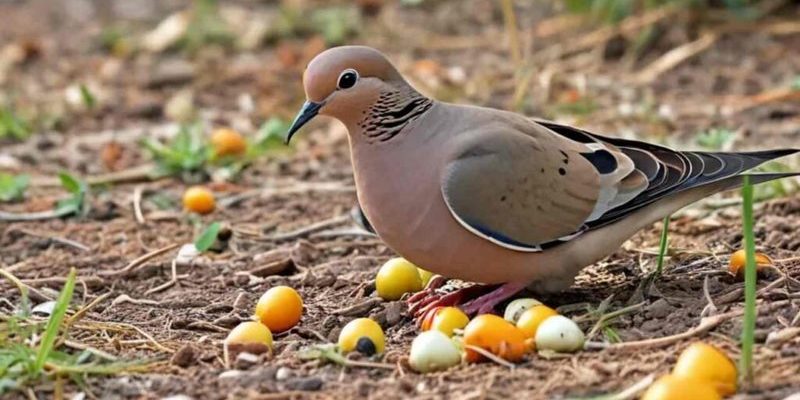
Understanding a Dove’s Diet
Doves primarily feast on seeds, grains, and fruits. That might sound simple, but their diet can vary based on their habitat and the time of year. In urban areas, you’ll often find doves snacking on seeds scattered by bird feeders or leftover grains from farms. Their strong, small beaks are perfect for pecking at the ground or sifting through the leaves to find hidden treats.
In the wild, they also enjoy a variety of berries and fruits. You might see them flitting through trees, happily munching on ripe blackberries or wild cherries. The emphasis on seeds doesn’t mean doves are picky eaters; they know how to make the most of what’s available. This adaptability is part of what makes them so successful in different environments.
Foraging Behavior
Foraging is a critical skill for doves. They often use a method called “ground foraging,” which might look a bit like a dance. Doves will hop around, often in a slow and deliberate manner, peering down at the ground to spot seeds and other food. This behavior not only allows them to find food but also keeps them alert for any nearby predators.
You might be surprised to learn that doves can eat while walking. They use their strong feet to scratch at the ground, making it easier to uncover seeds. As they forage, they tend to forage in small groups. This social behavior can help them stay safe from predators and keep them company while they search for food. Have you ever noticed how doves seem to have a buddy system? It’s not just for fun; it’s strategy.
Water Sources: A Key Part of Their Diet
Just like us, doves need water to survive. They tend to drink early in the morning or late in the day, often visiting bird baths or shallow water sources. It’s common to see them take a few sips, then flap away to find some seeds. They’re pretty smart about conserving energy, often drinking while foraging to maximize their time.
Choosing reliable water sources is crucial for their survival. Doves can become dehydrated, especially during hot summer months or when food is scarce. That’s why providing a water source in your yard can help support these beautiful birds. It’s a win-win situation: you get to enjoy their serene presence, and they get a much-needed refreshment.
Seasonal Changes in Their Diet
Doves are versatile eaters, but their diets do shift with the seasons. In spring and summer, when seeds are plentiful and fruits ripen, doves may eat more of these fresh foods. You might spot them in gardens, happily pecking at sunflowers or enjoying juicy berries. It’s like they’re hosting a little buffet!
As autumn approaches, their focus may change. They look for seeds that can be found on the ground. Many farmers leave behind grain after harvest, which can be a feast for these birds. The winter months might be tougher, but doves adapt by relying on their memory of where food is found. They may also visit feeders more frequently, taking advantage of the seeds that you provide.
How Doves Hunt in the Wild
Hunting for food isn’t just about pecking at the ground. Doves have a few tricks up their wings! While they don’t hunt in the classical sense like raptors, they do exhibit certain strategies that help them find food. For instance, doves often have a keen eye for spotting food from above. They may circle around before landing to scope out the area, ensuring that they’re choosing a safe spot with a good food supply.
You might also see them engaging in a behavior called “picking.” This involves using their beaks to sift through grass or brush, discovering hidden seeds beneath the surface. It’s a bit like treasure hunting for them! This patience and resourcefulness are what help them thrive in various environments, whether it’s a city park or a vast, open field.
Predators and Threats to Doves
While doves are experts at foraging, they must also be cautious of predators. Animals like hawks, cats, and snakes can pose a threat. Their best defense is staying alert and using their strong flight skills to escape. When foraging, they often keep a watchful eye, ready to take off if danger approaches.
You might be wondering what this means for their foraging habits. Doves tend to avoid foraging in open areas and instead look for places with plenty of cover, like bushes or tall grass. This helps them stay hidden while they hunt for their meals. It’s interesting how their survival instincts shape their behaviors, ensuring they find food while staying safe.
Creating a Dove-Friendly Environment
If you enjoy watching doves and want to create a welcoming space for them in your yard, there are several easy steps you can take. Start by planting native plants that produce seeds and berries. Sunflowers, thistles, and viburnum are excellent choices! You could also set up feeders filled with sunflower seeds or millet, providing them a reliable food source.
Adding a water feature, like a birdbath, can create a perfect oasis for doves. Ensure it has shallow areas for them to drink and bathe safely. Keeping the environment peaceful and predator-free will encourage doves to visit more often. Providing these resources not only supports their diet but also enhances your outdoor experience.
In conclusion, understanding what the dove eats and how it hunts or forages opens a window into their fascinating lives. These small birds are adaptable, resourceful, and skilled at finding their meals, making them a beautiful addition to any landscape. By creating a dove-friendly environment, you can enjoy watching them thrive right in your backyard. Whether you’re merely curious or an avid birdwatcher, appreciating doves and their foraging habits can be quite rewarding.

